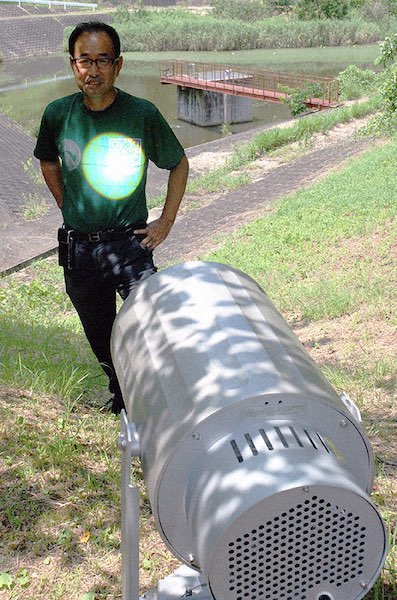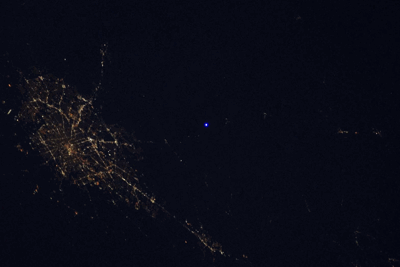Home
A comprehensive resource for safe and responsible laser use
Japan: Laser searchlight proposed to use QR codes to rescue hikers and climbers
The team, which is conducting the experiment at a campus in the western Japan city of Nara, has successfully scanned the two-dimensional code from a distance of about 300 meters and aims to put the system into practical use in the near future.
The code for the system measures about 11 centimeters (4.3 inches) on each side and is made from a retroreflective material. The print employs the same principle as that for reflecting road signs and can be scanned by a powerful laser searchlight.

A laser searchlight lights up a QR code on professor Yoshinobu Maeda's shirt at a Kindai University campus in the city of Nara. (Mainichi/Yasuhiro Okawa)
In responding to an actual situation, the team works on the assumption that a large laser emitter will be loaded on a helicopter to scan the mountain surface. The machine can spot a QR code from the light reflected from the ground. It's possible to identify a disaster or accident victim if their personal information, such as name and sex, has been registered with the code.
The system is being developed by a team consisting of scientists at the Faculty of Science and Engineering, and the Faculty of Architecture at the university.
Team leader Yoshinobu Maeda, a professor with the Faculty of Science and Engineering, said, "The system is technically advanced to a level where it can be introduced. The problem is how we spread its use. It's necessary for many people who enter mountain areas to wear clothes with QR codes and for helicopters to be equipped with laser searchlights."
From The Mainichi
US: Amateur astronomers illuminate International Space Station with spotlights and 1-watt laser

Two-frame animated GIF showing bright and dim light from the Lozano Observatory (center) near the city of San Antonio (left). North is to the right in this photo from the International Space Station, taken by astronaut Don Pettit. Click on photo for a larger version.
The spotlights were flashed at the ISS by holding plywood sheets in front of the lights every two seconds. This procedure can be seen in the video below.
The animated GIF above shows a bright blue light alternating with a dim light. The bright light is almost certainly from the spotlights. The bluish tint may be an artifact of oversaturating the camera’s sensor. Astronaut Don Pettit reported that the bright light appeared white, and the dim light appeared blue. He wrote “We could only see the laser when the white light was off and not all the time.” (E.g., the white spotlights overpowered the blue laser.) He added, “It was like there were tracking issues with the laser to keep it on target.”
The dim light in the animated GIF may be the laser only, or it may be light from the spotlights that wasn’t fully blocked by the plywood sheets. The astronomers will be working with Pettit, trying to pin down exactly how visible the laser light was.
US: Va. Beach wants state of Va. to ban aiming lasers at airplanes
The City Council is considering a local law to make malicious shining of lasers a Class 1 misdemeanor (up to a year in jail and a $2500 fine). According to PilotOnline.com, in 1998 Virginia Beach “was one of the first in the nation to make it a crime to shine lasers at police officers or into people’s eyes.”
The city is also planing an educational campaign to inform people about the law and laser dangers.
Commenter “Lost_Sailor” said there already is a Virginia state code, 5.1-22, “Interference with operation of aircraft,” to address the problem. He linked to a 2002 Virginia Court of Appeals case upholding the conviction of a man for using a “million candlelight spotlight” to illuminate a police helicopter. The man unsuccessfully argued that he had no intent to interfere with the helicopter; he wanted to view its registration number for a noise complaint. The man also unsuccessfully argued that his spotlight did not interfere with the operation of the aircraft.
From PilotOnline.com. The comment by Lost_Sailor was submitted on Thursday, 10/06/2011 at 6:40 pm.